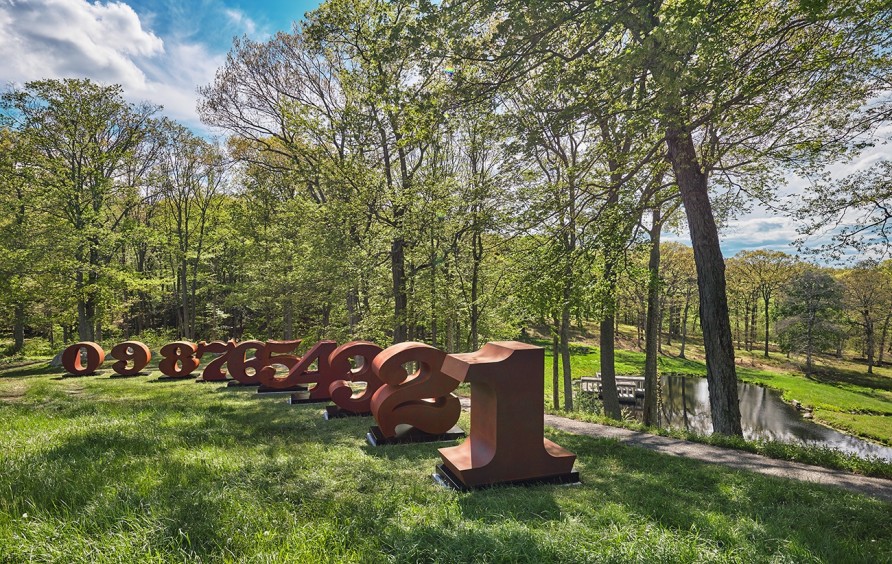Robert Indiana: ONE through Zero
"Numbers fill my life.
They fill my life even more than love.
We are immersed in numbers from the moment we are born….
By creating them, I’ve invested those numbers with a quality they have never had before.*"– Robert Indiana.
The Glass House is pleased to present the first public installation world-wide of the complete set of Robert Indiana’s ONE through ZERO, ten 6-foot-high COR-TEN steel sculptures that were conceived in 1980 and executed in 2003. Visitors will find these monumental works located in a field just to the south of the Glass House itself, where they have been placed to accentuate the edge of the hill that separates the house from the pond and pavilion below. Taking advantage of the changes of level in the landscape and the visual connections with many highlights of the property, the installation conjoins Philip Johnson and Robert Indiana’s visionary approach to industrial materials, proportion, form and the understanding of space.
The positioning of the sculptures allows them to be seen directly from the Glass House, while establishing sightlines from the artworks to other significant pavilions and structures, including the Studio, Ghost House and Da Monsta. The site is also notable as an area where Philip Johnson considered placing a small chapel toward the end of his life. The installation of ONE through ZERO is in keeping with Johnson’s approach to placing pavilions and structures within the landscape.
The Glass House welcomes visitors to explore how these powerful works interact with our landscape and respond to light and shadow throughout the seasons. The work will remain on view through November 2017. Numbers first appeared in Indiana’s work in the late 1950s. Inspired by abandoned materials that he found in the studio he’d taken on Coenties Slip in lower Manhattan—an old printer’s calendar, and a set of brass die-cut stencils that were relics of the shipping trade—he started to apply letters and numbers to his sculptural assemblages and paintings. Indiana has said that “the numbers had a kind of robustness and…crude vigor which I liked.”
Stenciled numbers and letters were features of the wooden sculptures that first attracted Philip Johnson’s attention to Indiana’s work. When Indiana’s sculpture LAW (1960-62) was exhibited in 1962 at The Museum of Modern Art, Johnson purchased the work, invited Indiana to visit the Glass House and proposed that the artist might create a work for the New York State Pavilion that Johnson was designing for the upcoming World’s Fair. (Johnson subsequently donated LAW to MoMA’s permanent collection.) In late October 1962, Johnson purchased Indiana’s painting A Divorced Man Has Never Been the President (1961) from the artist’s first solo exhibition at Stable Gallery and installed the work at the Glass House. Indiana became one of ten artists (including Ellsworth Kelly, Robert Rauschenberg, James Rosenquist and Andy Warhol) to create works for the exterior of the New York State Pavilion at the World’s Fair. When the New York State Theater — also designed by Philip Johnson — opened at Lincoln Center in 1964, the poster for it was based on a painting created by Indiana for the New York State Theater’s lobby. The image featured elements that by this time were signatures of Indiana: letters and numbers executed in a bold, stencil-like style.
As art historian and curator Barbara Haskell explains,“Numbers had appeared in Indiana’s work even before words, functioning variously as the abstract ‘names’ of his anthropomorphic herms, as metaphors for the passage of time, and as reminders of vernacular American culture.” Several suites of paintings in the 1960s and 1970s—including The Numbers (1965) and Decade Autoportraits (1972-1976) were significant precedents for the monumental sculptures of ONE through ZERO.
Indiana has stated that each number represents a stage of life, beginning with One (birth) and continuing through Nine (old age) and Zero (death). According to renowned art historian John Wilmerding, Indiana’s numbers can be considered akin to 19th-century artist Thomas Cole’s series of paintings on the ages of man. Indiana has noted that a 19th-century metaphorical print entitled The Life and Age of Man: Stages of Man’s Life from the Cradle to the Grave, inspired him as he created this sculptural series. This print was given to Indiana while he was an artist in residence at Dartmouth College in 1969 and remains in his personal collection.
As the Glass House commemorates its 10th year as a site of the National Trust for Historic Preservation, this 10-sculpture installation is especially appropriate, since COR-TEN steel was a material favored by Johnson and lines the paths linking the Glass House and its sister building, the Brick House. The combination of monumentality, wit and underlying seriousness of intention makes ONE through ZERO especially suited for exhibition at our site, which at its heart continues to celebrate the ethos of Philip Johnson and David Whitney.
The exhibition is organized by Chief Curator & Creative Director Hilary Lewis and Cole Akers, Curator and Special Projects Manager. Architectural and exhibition assistance was provided by Aaron McDonald, ADG McDonald Architects.
The exhibition has been made possible through generous support from the Morgan Art Foundation and the Salama-Caro family.
*Robert Indiana, cited in Indiana’s Indianas: a 20-year Retrospective of Paintings And Sculpture from the Collection of Robert Indiana. Exh. cat. (Rockland: William A. Farnsworth Library and Art Museum, 1982), p. 7.







